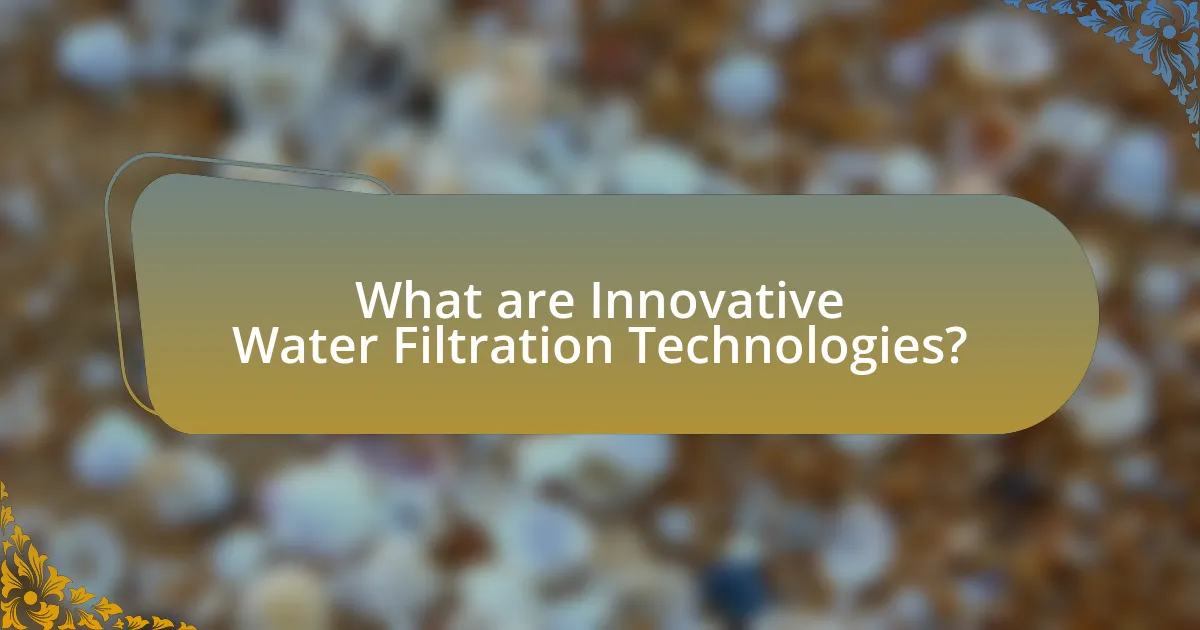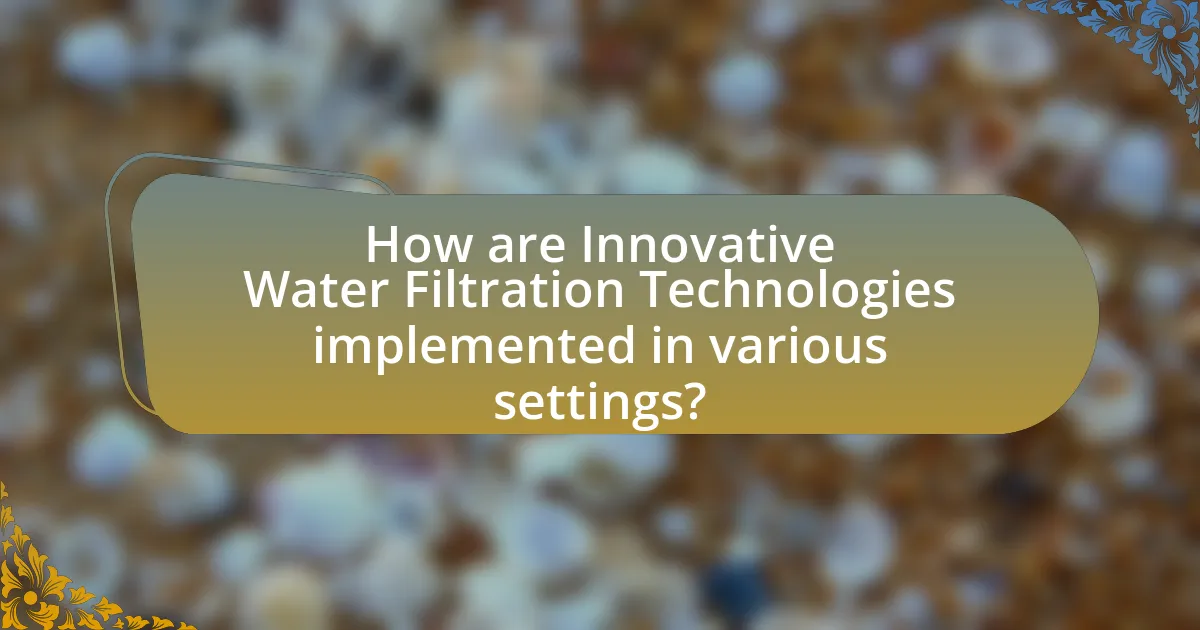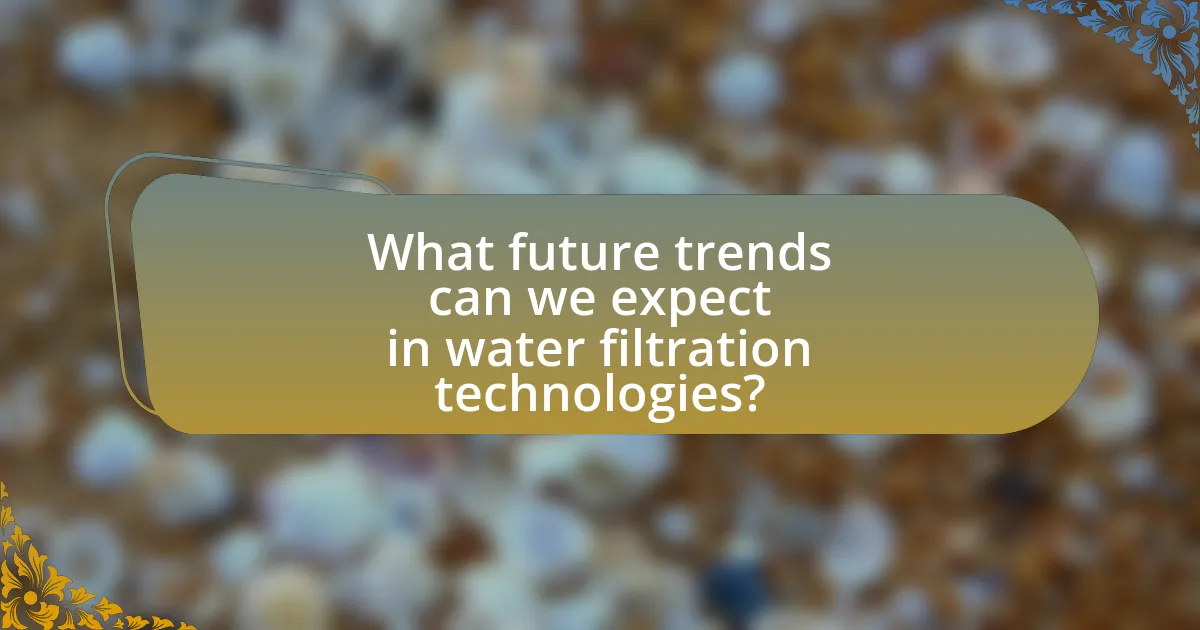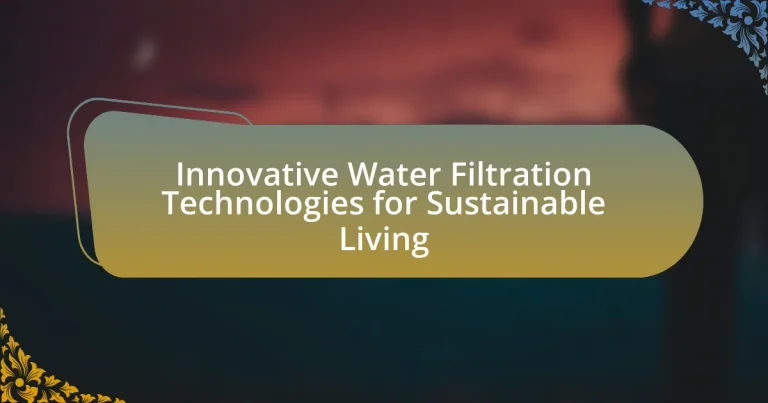Innovative water filtration technologies are advanced methods aimed at purifying water to enhance its quality and safety for consumption. This article explores various filtration techniques, including membrane filtration, advanced oxidation processes, and biofiltration, highlighting their effectiveness in removing contaminants and pathogens. It discusses the environmental impacts of traditional filtration methods, the role of these technologies in promoting sustainable living, and their applications in urban and rural settings. Additionally, the article addresses challenges such as cost and scalability, while examining future trends and advancements in water purification technologies, including nanotechnology and artificial intelligence.

What are Innovative Water Filtration Technologies?
Innovative water filtration technologies are advanced methods designed to purify water, enhancing its quality and safety for consumption. These technologies include membrane filtration, such as reverse osmosis and nanofiltration, which effectively remove contaminants at the molecular level. Additionally, advanced oxidation processes utilize chemical reactions to eliminate pollutants, while biofiltration employs natural organisms to break down harmful substances. Research indicates that these technologies can significantly reduce waterborne diseases and improve access to clean water, contributing to sustainable living practices. For instance, a study published in the journal “Water Research” highlights that membrane filtration can achieve over 99% removal of pathogens, demonstrating their effectiveness in ensuring safe drinking water.
How do these technologies contribute to sustainable living?
Innovative water filtration technologies contribute to sustainable living by providing efficient methods for purifying water, reducing waste, and minimizing environmental impact. These technologies, such as membrane filtration and solar-powered systems, enhance water quality while conserving resources. For instance, membrane filtration can remove contaminants without the need for harmful chemicals, thus preserving aquatic ecosystems. Additionally, solar-powered filtration systems utilize renewable energy, decreasing reliance on fossil fuels and lowering carbon emissions. According to a study published in the Journal of Cleaner Production, implementing advanced filtration technologies can lead to a 30% reduction in water usage and a significant decrease in energy consumption, demonstrating their effectiveness in promoting sustainability.
What are the environmental impacts of traditional water filtration methods?
Traditional water filtration methods can have significant environmental impacts, primarily through the consumption of resources and the generation of waste. These methods often rely on materials such as sand, charcoal, and chemicals, which require extraction and processing, leading to habitat disruption and resource depletion. For instance, the mining of sand for filtration can result in erosion and loss of biodiversity in aquatic ecosystems. Additionally, the use of chemical coagulants in some filtration processes can lead to chemical runoff, contaminating local water sources and harming aquatic life. Furthermore, traditional systems may produce waste sludge that requires disposal, often leading to landfill use or further environmental contamination. These factors collectively highlight the ecological footprint of conventional water filtration practices.
How do innovative technologies reduce water waste?
Innovative technologies reduce water waste by implementing advanced filtration systems and smart water management solutions. These technologies, such as membrane filtration and real-time monitoring sensors, enhance water efficiency by minimizing leaks and optimizing usage. For instance, membrane filtration can remove contaminants while allowing for the reuse of treated water, significantly decreasing the demand for fresh water. Additionally, smart irrigation systems utilize data analytics to adjust water application based on weather conditions and soil moisture levels, which can reduce water consumption by up to 50% in agricultural practices.
What types of innovative water filtration technologies exist?
Innovative water filtration technologies include membrane filtration, activated carbon filtration, UV disinfection, and advanced oxidation processes. Membrane filtration utilizes semi-permeable membranes to separate contaminants from water, effectively removing bacteria and viruses. Activated carbon filtration employs carbon to adsorb impurities, enhancing taste and odor while reducing harmful chemicals. UV disinfection uses ultraviolet light to inactivate microorganisms, providing a chemical-free method of purification. Advanced oxidation processes combine ozone, hydrogen peroxide, or UV light to break down organic pollutants, ensuring high-quality water. These technologies are supported by research indicating their effectiveness in improving water quality and sustainability.
What is the role of membrane filtration in water purification?
Membrane filtration plays a crucial role in water purification by effectively removing contaminants such as bacteria, viruses, and suspended solids from water. This technology utilizes semi-permeable membranes that allow water molecules to pass through while blocking larger particles and impurities. Studies have shown that membrane filtration can achieve high levels of purification, with microfiltration and ultrafiltration membranes capable of removing particles as small as 0.1 microns, significantly improving water quality. Additionally, reverse osmosis membranes can remove dissolved salts and organic compounds, making them essential for producing potable water from seawater or contaminated sources.
How does UV filtration work to eliminate pathogens?
UV filtration eliminates pathogens by using ultraviolet light to disrupt their DNA or RNA, rendering them unable to reproduce and effectively inactivating them. This process involves exposing water to UV light at specific wavelengths, typically around 254 nanometers, which is highly effective against bacteria, viruses, and protozoa. Studies have shown that UV filtration can achieve a 99.99% reduction in pathogens, making it a reliable method for ensuring safe drinking water. The effectiveness of UV filtration is supported by the World Health Organization, which recognizes it as a viable technology for water disinfection.
What are the benefits of activated carbon filters?
Activated carbon filters provide several benefits, including effective removal of contaminants, improvement of water taste and odor, and reduction of harmful chemicals. These filters utilize a porous structure that adsorbs impurities such as chlorine, volatile organic compounds (VOCs), and heavy metals, making water safer for consumption. Studies have shown that activated carbon can remove up to 99% of chlorine and significantly reduce other pollutants, enhancing overall water quality. Additionally, the use of activated carbon filters is environmentally friendly, as they can be regenerated and reused, contributing to sustainable living practices.
What challenges do innovative water filtration technologies face?
Innovative water filtration technologies face several challenges, including high costs, scalability issues, and regulatory hurdles. High costs can limit accessibility for widespread adoption, as advanced filtration systems often require significant investment in materials and technology. Scalability issues arise when attempting to implement these technologies in diverse environments, as solutions effective in one context may not perform well in another. Regulatory hurdles can impede innovation, as existing water quality standards may not accommodate new technologies, delaying their deployment. These challenges collectively hinder the potential impact of innovative water filtration technologies on sustainable living.
How do cost and accessibility affect the adoption of these technologies?
Cost and accessibility significantly influence the adoption of innovative water filtration technologies for sustainable living. High costs can deter individuals and communities from investing in these technologies, as many may lack the financial resources to purchase or maintain advanced filtration systems. For instance, a study by the World Health Organization indicates that affordable water purification solutions are crucial for widespread adoption, particularly in low-income regions where access to clean water is limited. Additionally, accessibility to these technologies, including availability in local markets and ease of installation, directly impacts their uptake. If innovative filtration systems are not readily available or require complex installation processes, potential users are less likely to adopt them. Therefore, addressing both cost and accessibility is essential for enhancing the adoption of water filtration technologies.
What are the limitations of current filtration technologies?
Current filtration technologies face several limitations, including inefficiency in removing certain contaminants, high operational costs, and limited scalability. For instance, conventional methods like activated carbon filters may not effectively eliminate heavy metals or pathogens, which can compromise water quality. Additionally, advanced filtration systems, such as reverse osmosis, often require significant energy and maintenance, making them less accessible for widespread use. Furthermore, many filtration technologies struggle to adapt to varying water quality conditions, limiting their effectiveness in diverse environments. These challenges highlight the need for ongoing innovation in water filtration solutions to enhance sustainability and accessibility.

How are Innovative Water Filtration Technologies implemented in various settings?
Innovative water filtration technologies are implemented in various settings through the integration of advanced materials and processes tailored to specific water quality challenges. For instance, in urban areas, membrane filtration systems are utilized to treat wastewater, effectively removing contaminants and enabling water reuse; studies show that these systems can achieve over 90% removal of pollutants. In rural settings, solar-powered filtration units are deployed to provide clean drinking water, leveraging renewable energy to operate filtration membranes, which can reduce reliance on fossil fuels. Additionally, in industrial applications, activated carbon filters are employed to remove volatile organic compounds from process water, enhancing compliance with environmental regulations. These implementations demonstrate the versatility and effectiveness of innovative filtration technologies across diverse environments, contributing to sustainable water management practices.
What are the applications of these technologies in urban areas?
Innovative water filtration technologies have several applications in urban areas, primarily aimed at improving water quality and sustainability. These technologies can be integrated into municipal water systems to enhance the treatment of drinking water, ensuring it meets health standards. For instance, advanced filtration methods like membrane filtration and activated carbon systems are utilized to remove contaminants and pollutants from water sources, thereby providing safer drinking water to urban populations. Additionally, these technologies can be employed in decentralized systems, such as rainwater harvesting and greywater recycling, which promote water conservation and reduce the demand on centralized water supply systems. The implementation of such technologies has been shown to decrease waterborne diseases and improve public health outcomes in urban settings, as evidenced by studies indicating a significant reduction in contaminants in treated water.
How do residential systems differ from commercial systems?
Residential systems differ from commercial systems primarily in scale and complexity. Residential water filtration systems are designed for individual households, typically addressing basic water quality needs such as taste, odor, and contaminants, often utilizing simpler technologies like activated carbon filters or reverse osmosis units. In contrast, commercial systems cater to larger facilities, requiring advanced filtration technologies capable of handling higher volumes and more complex contaminants, such as industrial pollutants or pathogens, often employing multi-stage filtration processes and automated monitoring systems. For instance, commercial systems may include UV disinfection and advanced membrane filtration to ensure compliance with stricter regulatory standards, reflecting the need for higher efficiency and reliability in larger operations.
What role do these technologies play in disaster relief efforts?
Innovative water filtration technologies play a crucial role in disaster relief efforts by providing safe drinking water to affected populations. These technologies, such as portable filtration systems and solar-powered purifiers, enable rapid deployment in emergency situations where access to clean water is compromised. For instance, during the 2010 Haiti earthquake, portable water filtration units were essential in delivering potable water to thousands of displaced individuals, significantly reducing the risk of waterborne diseases. The effectiveness of these technologies in disaster scenarios is evidenced by their ability to filter contaminants and produce clean water quickly, which is vital for health and survival in crisis situations.
How can communities benefit from adopting innovative water filtration solutions?
Communities can benefit from adopting innovative water filtration solutions by improving public health, enhancing water quality, and promoting environmental sustainability. Innovative filtration technologies, such as membrane filtration and advanced oxidation processes, effectively remove contaminants, pathogens, and pollutants from water sources, leading to safer drinking water. For instance, a study published in the Journal of Water and Health found that communities using advanced filtration systems experienced a 50% reduction in waterborne diseases. Additionally, these solutions often require less energy and fewer chemicals, reducing the environmental impact associated with traditional water treatment methods. By implementing such technologies, communities can ensure access to clean water, reduce healthcare costs, and contribute to a more sustainable ecosystem.
What educational programs support the use of these technologies?
Educational programs that support the use of innovative water filtration technologies include university courses in environmental engineering, sustainable development, and water resource management. These programs often incorporate hands-on training with advanced filtration systems and emphasize the importance of sustainable practices in water management. For instance, institutions like Stanford University and the Massachusetts Institute of Technology offer specialized courses that focus on water treatment technologies and their applications in real-world scenarios, providing students with both theoretical knowledge and practical skills.
How do community initiatives promote sustainable water practices?
Community initiatives promote sustainable water practices by fostering local engagement and education around water conservation and management. These initiatives often involve workshops, community clean-up events, and collaborative projects that raise awareness about the importance of sustainable water use. For example, programs like the “WaterWise” initiative in various cities have demonstrated that community-led efforts can lead to a significant reduction in water consumption, with participants reporting up to a 30% decrease in usage after implementing conservation techniques learned through these initiatives. Additionally, community gardens and rainwater harvesting projects not only provide practical solutions for water sustainability but also strengthen community ties and encourage collective responsibility for local water resources.

What future trends can we expect in water filtration technologies?
Future trends in water filtration technologies include the increased use of advanced materials, such as graphene and nanomaterials, which enhance filtration efficiency and reduce energy consumption. Research indicates that these materials can effectively remove contaminants at a molecular level, leading to cleaner water with less waste. Additionally, the integration of smart technology, such as IoT-enabled filtration systems, allows for real-time monitoring and optimization of water quality, improving user experience and system maintenance. According to a report by MarketsandMarkets, the global water filtration market is projected to grow significantly, driven by rising water scarcity and the demand for sustainable solutions.
How is technology evolving to improve water filtration efficiency?
Technology is evolving to improve water filtration efficiency through advancements in materials and processes, such as the development of nanomaterials and membrane technologies. For instance, researchers have created nanofilters that utilize carbon nanotubes and graphene, which significantly enhance the removal of contaminants due to their high surface area and selective permeability. Additionally, innovations like bio-inspired filtration systems mimic natural processes, improving efficiency and reducing energy consumption. Studies have shown that these advanced filtration systems can achieve over 90% removal rates for various pollutants, demonstrating their effectiveness in providing clean water.
What advancements are being made in nanotechnology for water purification?
Advancements in nanotechnology for water purification include the development of nanomaterials such as graphene oxide membranes, which significantly enhance filtration efficiency by allowing water to pass through while blocking contaminants. Research published in the journal “Nature Nanotechnology” by researchers from Stanford University demonstrates that these membranes can achieve over 90% rejection of salts and organic molecules, making them highly effective for desalination and wastewater treatment. Additionally, nanoparticles like silver and titanium dioxide are being utilized for their antimicrobial properties, effectively eliminating pathogens in water. These innovations are paving the way for more sustainable and efficient water purification methods.
How might artificial intelligence enhance filtration systems?
Artificial intelligence can enhance filtration systems by optimizing their performance through real-time data analysis and predictive maintenance. AI algorithms can analyze water quality parameters, such as turbidity and contaminant levels, to adjust filtration processes dynamically, ensuring maximum efficiency and effectiveness. For instance, a study published in the journal “Water Research” demonstrated that AI-driven systems could reduce energy consumption by up to 30% while maintaining high filtration standards. This capability not only improves the operational efficiency of filtration systems but also extends their lifespan by predicting failures before they occur, thereby reducing downtime and maintenance costs.
What are the best practices for maintaining water filtration systems?
The best practices for maintaining water filtration systems include regular inspection, timely replacement of filters, and proper cleaning of components. Regular inspection helps identify any wear or damage, ensuring the system operates efficiently. Timely replacement of filters is crucial; for example, activated carbon filters typically need replacement every 6 to 12 months, depending on usage and water quality. Proper cleaning of components, such as membranes in reverse osmosis systems, can enhance performance and longevity. Following these practices can significantly improve the effectiveness and lifespan of water filtration systems.
How often should filters be replaced for optimal performance?
Filters should be replaced every 6 to 12 months for optimal performance, depending on usage and water quality. Regular replacement ensures that the filtration system operates efficiently, removing contaminants effectively. For instance, the Environmental Protection Agency (EPA) recommends monitoring filter performance and replacing them as needed to maintain water quality standards.
What troubleshooting tips can help users maximize their filtration systems?
To maximize filtration systems, users should regularly check and replace filters according to the manufacturer’s guidelines. This ensures optimal performance, as clogged or worn-out filters can significantly reduce water quality and flow rate. Additionally, users should inspect the system for leaks or blockages, as these issues can compromise filtration efficiency. Regular maintenance, including cleaning components and monitoring water pressure, helps maintain system integrity and prolongs lifespan. Following these troubleshooting tips can enhance the effectiveness of filtration systems, ensuring cleaner and safer water for sustainable living.


